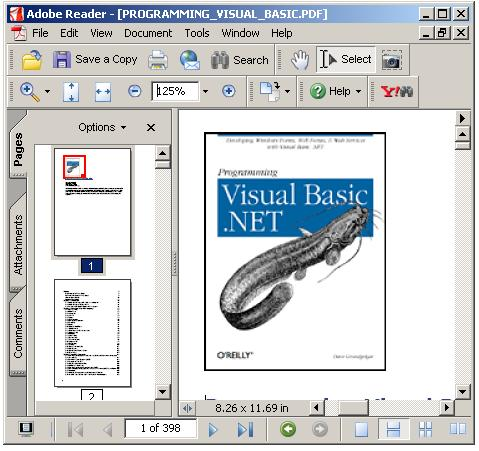Programming Visual Basic.NET Book
- Category
- Programming
- Visual Basic Components A-G

- Developer: Helpsofts VB
- Home page: visualbasic-6.com
- License type: Commercial
- Size: 2.03 MB
- Download
Review
Programming Visual Basic .NET Preface Organization of This Book Conventions Used in This Book How to Contact Us Acknowledgments 1. Introduction 1.1 What Is the Microsoft .NET Framework? 1.2 What Is Visual Basic .NET? 1.3 An Example Visual Basic .NET Program 2. The Visual Basic .NET Language 2.1 Source Files 2.2 Identifiers 2.3 Keywords 2.4 Literals 2.5 Types 2.6 Namespaces 2.7 Symbolic Constants 2.8 Variables 2.9 Scope 2.10 Access Modifiers 2.11 Assignment 2.12 Operators and Expressions 2.13 Statements 2.14 Classes 2.15 Interfaces 2.16 Structures 2.17 Enumerations 2.18 Exceptions 2.19 Delegates 2.20 Events 2.21 Standard Modules 2.22 Attributes 2.23 Conditional Compilation 2.24 Summary 3. The .NET Framework 3.1 Common Language Infrastructure (CLI) and Common Language Runtime (CLR) 3.2 Common Type System (CTS) 3.3 Portions of the CLI 3.4 Modules and Assemblies 3.5 Application Domains 3.6 Common Language Specification (CLS) 3.7 Intermediate Language (IL) and Just-In-Time (JIT) Compilation 3.8 Metadata 3.9 Memory Management and Garbage Collection 3.10 A Brief Tour of the .NET Framework Namespaces 3.11 Configuration 3.12 Summary 4. Windows Forms I: Developing Desktop Applications 4.1 Creating a Form 4.2 Handling Form Events 4.3 Relationships Between Forms 6 4.4 MDI Applications 4.5 Component Attributes 4.6 2-D Graphics Programming with GDI+ 4.7 Printing 4.8 Summary 5. Windows Forms II: Controls, Common Dialog Boxes, and Menus 5.1 Common Controls and Components 5.2 Control Events 5.3 Form and Control Layout 5.4 Common Dialog Boxes 5.5 Menus 5.6 Creating a Control 5.7 Summary 6. ASP.NET and Web Forms: Developing Browser-Based Applications 6.1 Creating a Web Form 6.2 Handling Page Events 6.3 More About Server Controls 6.4 Adding Validation 6.5 Using Directives to Modify Web Page Compilation 6.6 ASP.NET Objects: Interacting with the Framework 6.7 Discovering Browser Capabilities 6.8 Maintaining State